Executive Analysis Report: Cluster and New Economics of Competition
VerifiedAdded on 2022/12/30
|8
|1793
|58
Report
AI Summary
This report provides an executive analysis of Michael Porter's article, "Cluster and New Economics of Competition." The analysis begins with a summary of the article, highlighting the concept of business clusters and their impact on competitive advantages in modern markets. It explores the evolution of cluster theory and its implications for organizational strategies, linking clusters to productivity, information flow, innovation, and new business formation. The report examines different perspectives on clusters and competition from various researchers and discusses the benefits of clusters in business innovation and development. It also explores the relationship between corporate strategy and clusters. The analysis concludes with key takeaways, limitations, and practical applications, including examples like Hollywood and the Italian leather cluster, offering insights into how clusters can be applied in various business scenarios. Finally, the report includes a discussion of lessons learned and potential questions for further discussion.
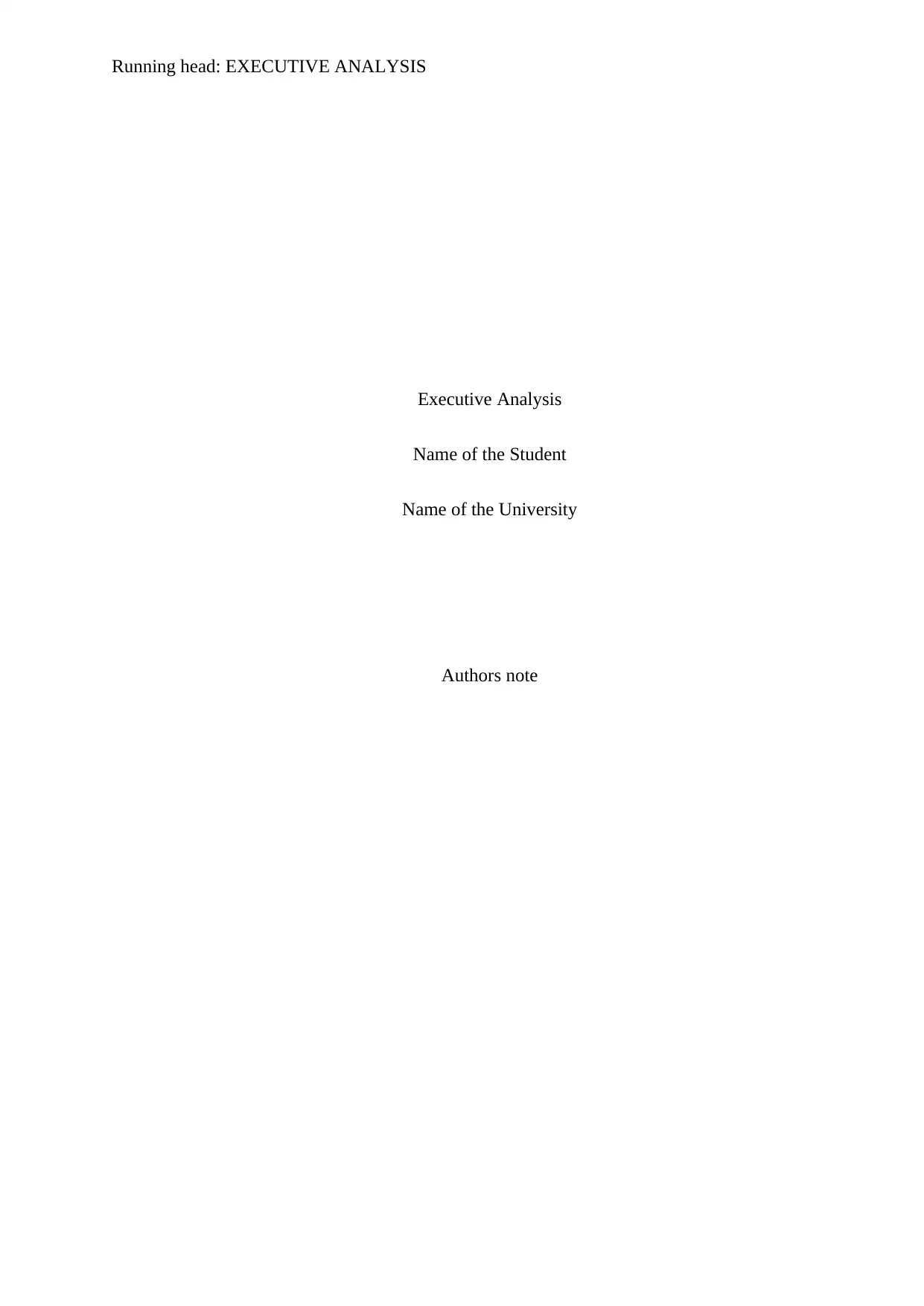
Running head: EXECUTIVE ANALYSIS
Executive Analysis
Name of the Student
Name of the University
Authors note
Executive Analysis
Name of the Student
Name of the University
Authors note
Paraphrase This Document
Need a fresh take? Get an instant paraphrase of this document with our AI Paraphraser
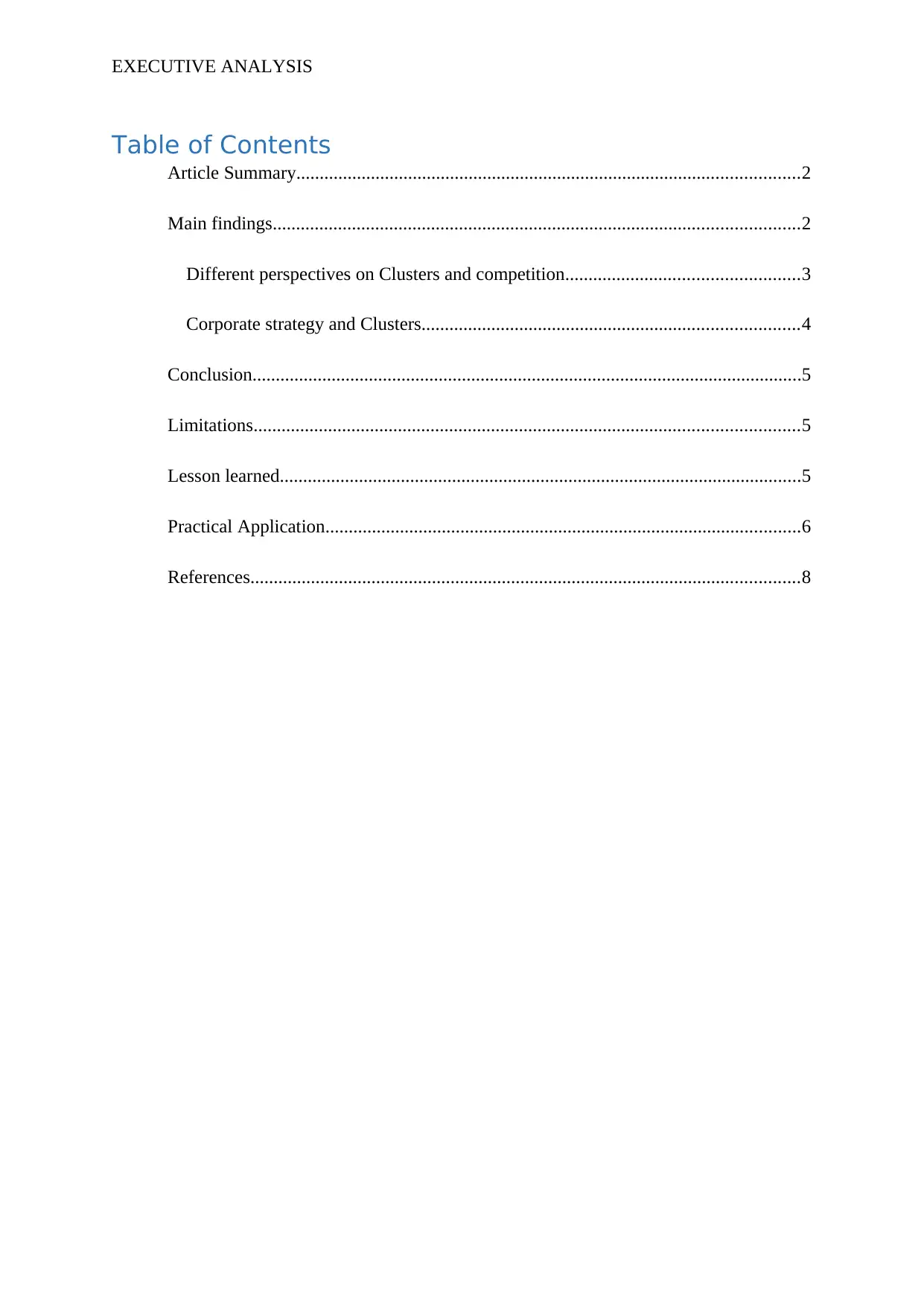
EXECUTIVE ANALYSIS
Table of Contents
Article Summary............................................................................................................2
Main findings.................................................................................................................2
Different perspectives on Clusters and competition..................................................3
Corporate strategy and Clusters.................................................................................4
Conclusion......................................................................................................................5
Limitations.....................................................................................................................5
Lesson learned................................................................................................................5
Practical Application......................................................................................................6
References......................................................................................................................8
Table of Contents
Article Summary............................................................................................................2
Main findings.................................................................................................................2
Different perspectives on Clusters and competition..................................................3
Corporate strategy and Clusters.................................................................................4
Conclusion......................................................................................................................5
Limitations.....................................................................................................................5
Lesson learned................................................................................................................5
Practical Application......................................................................................................6
References......................................................................................................................8
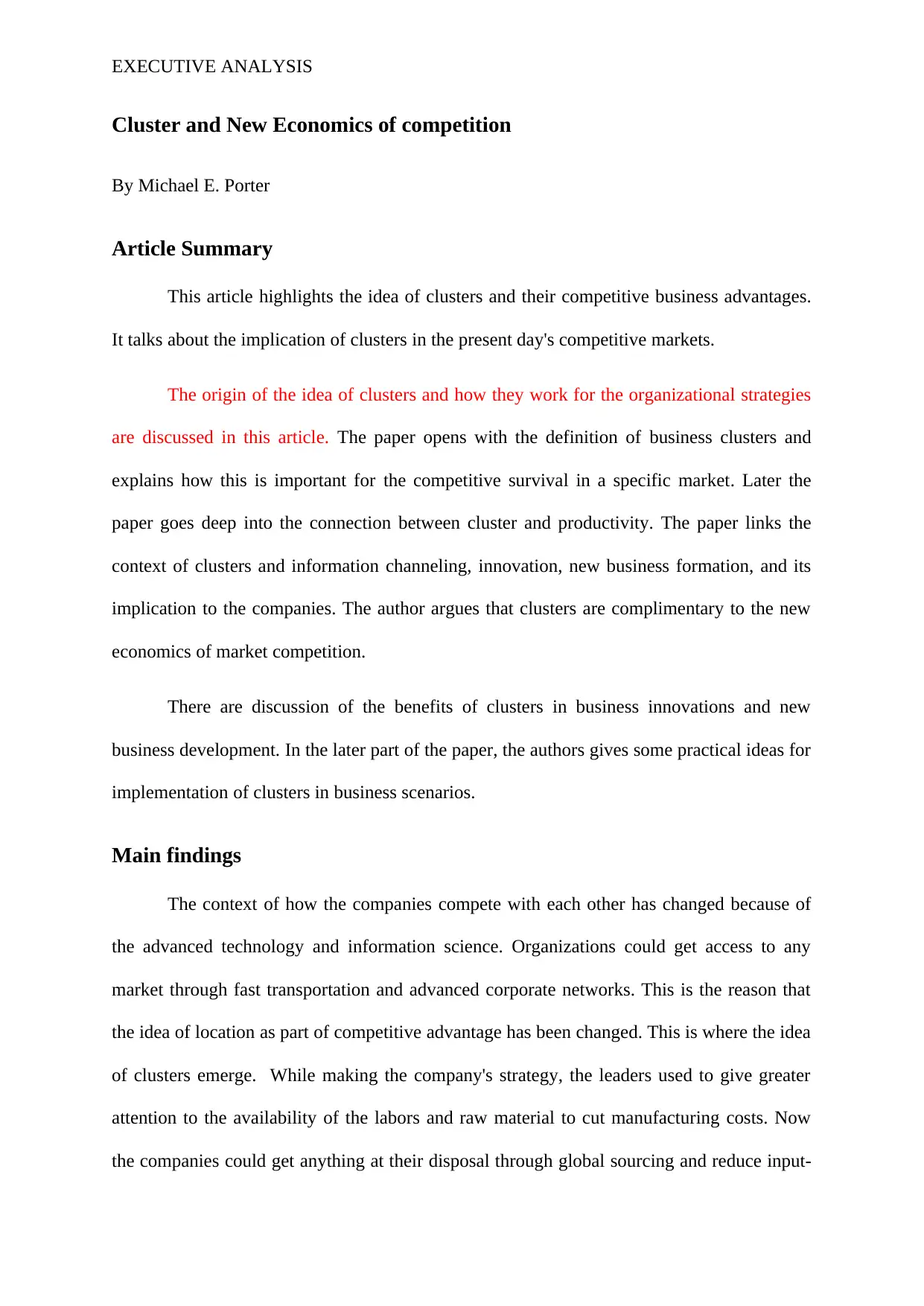
EXECUTIVE ANALYSIS
Cluster and New Economics of competition
By Michael E. Porter
Article Summary
This article highlights the idea of clusters and their competitive business advantages.
It talks about the implication of clusters in the present day's competitive markets.
The origin of the idea of clusters and how they work for the organizational strategies
are discussed in this article. The paper opens with the definition of business clusters and
explains how this is important for the competitive survival in a specific market. Later the
paper goes deep into the connection between cluster and productivity. The paper links the
context of clusters and information channeling, innovation, new business formation, and its
implication to the companies. The author argues that clusters are complimentary to the new
economics of market competition.
There are discussion of the benefits of clusters in business innovations and new
business development. In the later part of the paper, the authors gives some practical ideas for
implementation of clusters in business scenarios.
Main findings
The context of how the companies compete with each other has changed because of
the advanced technology and information science. Organizations could get access to any
market through fast transportation and advanced corporate networks. This is the reason that
the idea of location as part of competitive advantage has been changed. This is where the idea
of clusters emerge. While making the company's strategy, the leaders used to give greater
attention to the availability of the labors and raw material to cut manufacturing costs. Now
the companies could get anything at their disposal through global sourcing and reduce input-
Cluster and New Economics of competition
By Michael E. Porter
Article Summary
This article highlights the idea of clusters and their competitive business advantages.
It talks about the implication of clusters in the present day's competitive markets.
The origin of the idea of clusters and how they work for the organizational strategies
are discussed in this article. The paper opens with the definition of business clusters and
explains how this is important for the competitive survival in a specific market. Later the
paper goes deep into the connection between cluster and productivity. The paper links the
context of clusters and information channeling, innovation, new business formation, and its
implication to the companies. The author argues that clusters are complimentary to the new
economics of market competition.
There are discussion of the benefits of clusters in business innovations and new
business development. In the later part of the paper, the authors gives some practical ideas for
implementation of clusters in business scenarios.
Main findings
The context of how the companies compete with each other has changed because of
the advanced technology and information science. Organizations could get access to any
market through fast transportation and advanced corporate networks. This is the reason that
the idea of location as part of competitive advantage has been changed. This is where the idea
of clusters emerge. While making the company's strategy, the leaders used to give greater
attention to the availability of the labors and raw material to cut manufacturing costs. Now
the companies could get anything at their disposal through global sourcing and reduce input-
⊘ This is a preview!⊘
Do you want full access?
Subscribe today to unlock all pages.

Trusted by 1+ million students worldwide
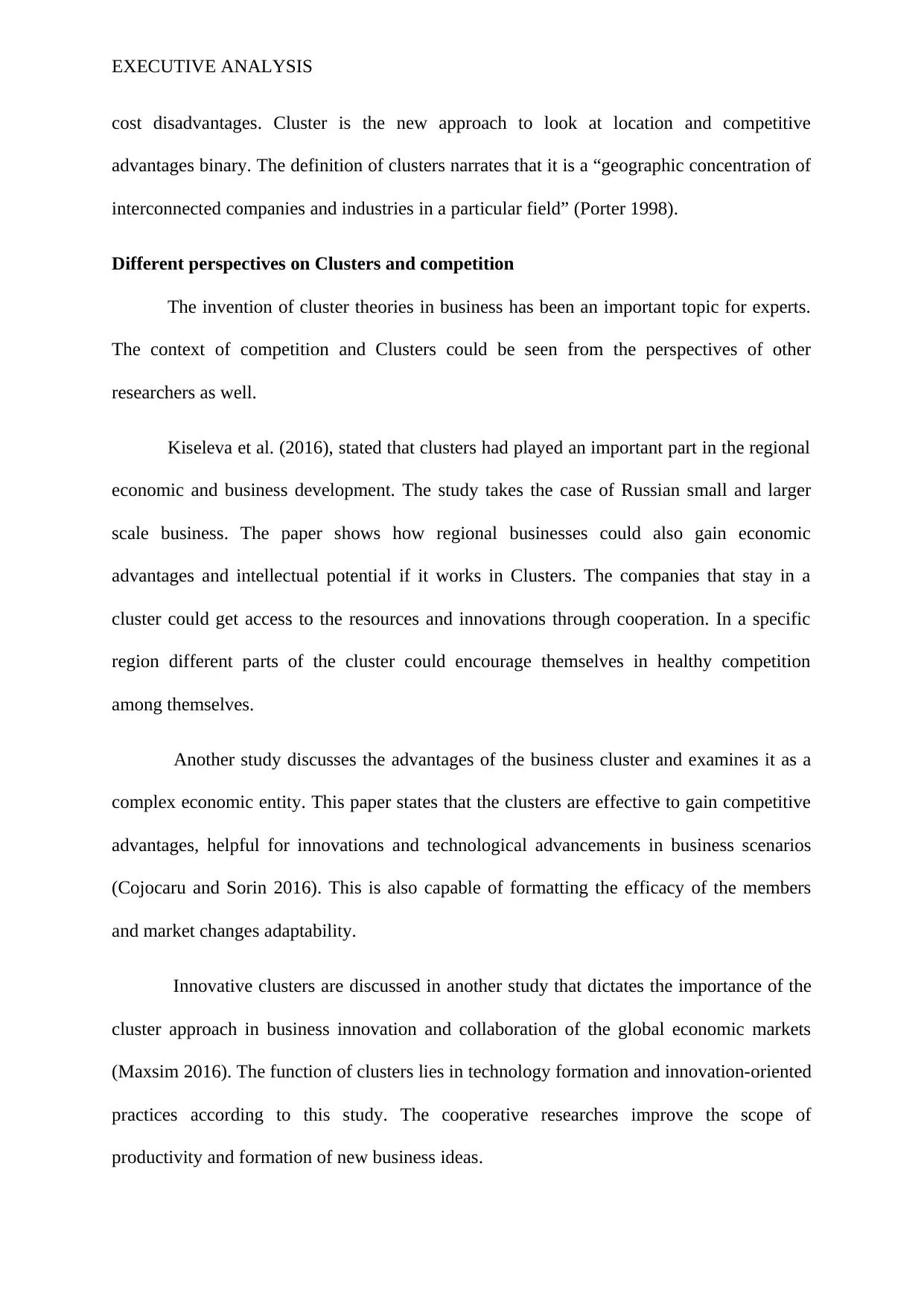
EXECUTIVE ANALYSIS
cost disadvantages. Cluster is the new approach to look at location and competitive
advantages binary. The definition of clusters narrates that it is a “geographic concentration of
interconnected companies and industries in a particular field” (Porter 1998).
Different perspectives on Clusters and competition
The invention of cluster theories in business has been an important topic for experts.
The context of competition and Clusters could be seen from the perspectives of other
researchers as well.
Kiseleva et al. (2016), stated that clusters had played an important part in the regional
economic and business development. The study takes the case of Russian small and larger
scale business. The paper shows how regional businesses could also gain economic
advantages and intellectual potential if it works in Clusters. The companies that stay in a
cluster could get access to the resources and innovations through cooperation. In a specific
region different parts of the cluster could encourage themselves in healthy competition
among themselves.
Another study discusses the advantages of the business cluster and examines it as a
complex economic entity. This paper states that the clusters are effective to gain competitive
advantages, helpful for innovations and technological advancements in business scenarios
(Cojocaru and Sorin 2016). This is also capable of formatting the efficacy of the members
and market changes adaptability.
Innovative clusters are discussed in another study that dictates the importance of the
cluster approach in business innovation and collaboration of the global economic markets
(Maxsim 2016). The function of clusters lies in technology formation and innovation-oriented
practices according to this study. The cooperative researches improve the scope of
productivity and formation of new business ideas.
cost disadvantages. Cluster is the new approach to look at location and competitive
advantages binary. The definition of clusters narrates that it is a “geographic concentration of
interconnected companies and industries in a particular field” (Porter 1998).
Different perspectives on Clusters and competition
The invention of cluster theories in business has been an important topic for experts.
The context of competition and Clusters could be seen from the perspectives of other
researchers as well.
Kiseleva et al. (2016), stated that clusters had played an important part in the regional
economic and business development. The study takes the case of Russian small and larger
scale business. The paper shows how regional businesses could also gain economic
advantages and intellectual potential if it works in Clusters. The companies that stay in a
cluster could get access to the resources and innovations through cooperation. In a specific
region different parts of the cluster could encourage themselves in healthy competition
among themselves.
Another study discusses the advantages of the business cluster and examines it as a
complex economic entity. This paper states that the clusters are effective to gain competitive
advantages, helpful for innovations and technological advancements in business scenarios
(Cojocaru and Sorin 2016). This is also capable of formatting the efficacy of the members
and market changes adaptability.
Innovative clusters are discussed in another study that dictates the importance of the
cluster approach in business innovation and collaboration of the global economic markets
(Maxsim 2016). The function of clusters lies in technology formation and innovation-oriented
practices according to this study. The cooperative researches improve the scope of
productivity and formation of new business ideas.
Paraphrase This Document
Need a fresh take? Get an instant paraphrase of this document with our AI Paraphraser
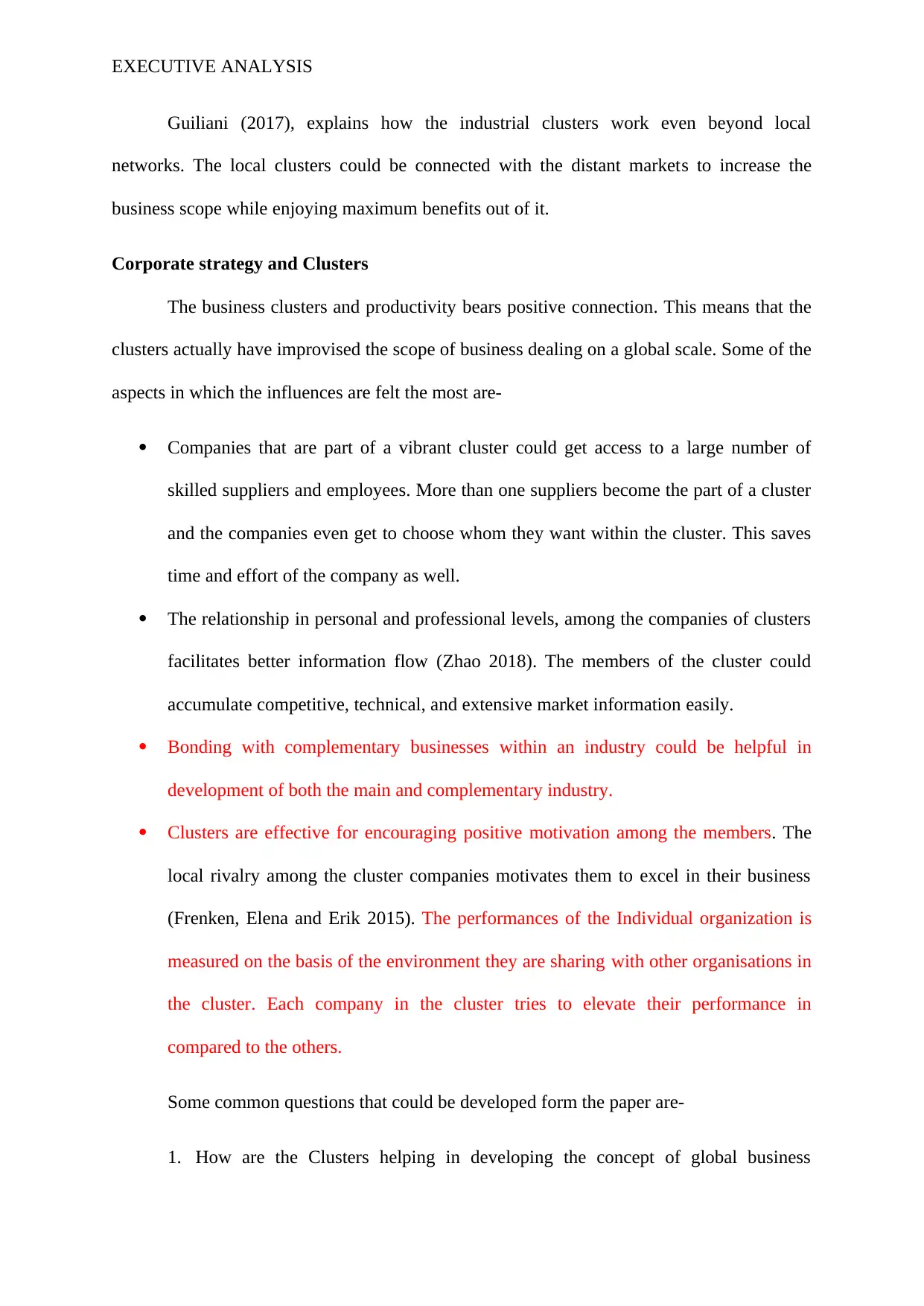
EXECUTIVE ANALYSIS
Guiliani (2017), explains how the industrial clusters work even beyond local
networks. The local clusters could be connected with the distant markets to increase the
business scope while enjoying maximum benefits out of it.
Corporate strategy and Clusters
The business clusters and productivity bears positive connection. This means that the
clusters actually have improvised the scope of business dealing on a global scale. Some of the
aspects in which the influences are felt the most are-
Companies that are part of a vibrant cluster could get access to a large number of
skilled suppliers and employees. More than one suppliers become the part of a cluster
and the companies even get to choose whom they want within the cluster. This saves
time and effort of the company as well.
The relationship in personal and professional levels, among the companies of clusters
facilitates better information flow (Zhao 2018). The members of the cluster could
accumulate competitive, technical, and extensive market information easily.
Bonding with complementary businesses within an industry could be helpful in
development of both the main and complementary industry.
Clusters are effective for encouraging positive motivation among the members. The
local rivalry among the cluster companies motivates them to excel in their business
(Frenken, Elena and Erik 2015). The performances of the Individual organization is
measured on the basis of the environment they are sharing with other organisations in
the cluster. Each company in the cluster tries to elevate their performance in
compared to the others.
Some common questions that could be developed form the paper are-
1. How are the Clusters helping in developing the concept of global business
Guiliani (2017), explains how the industrial clusters work even beyond local
networks. The local clusters could be connected with the distant markets to increase the
business scope while enjoying maximum benefits out of it.
Corporate strategy and Clusters
The business clusters and productivity bears positive connection. This means that the
clusters actually have improvised the scope of business dealing on a global scale. Some of the
aspects in which the influences are felt the most are-
Companies that are part of a vibrant cluster could get access to a large number of
skilled suppliers and employees. More than one suppliers become the part of a cluster
and the companies even get to choose whom they want within the cluster. This saves
time and effort of the company as well.
The relationship in personal and professional levels, among the companies of clusters
facilitates better information flow (Zhao 2018). The members of the cluster could
accumulate competitive, technical, and extensive market information easily.
Bonding with complementary businesses within an industry could be helpful in
development of both the main and complementary industry.
Clusters are effective for encouraging positive motivation among the members. The
local rivalry among the cluster companies motivates them to excel in their business
(Frenken, Elena and Erik 2015). The performances of the Individual organization is
measured on the basis of the environment they are sharing with other organisations in
the cluster. Each company in the cluster tries to elevate their performance in
compared to the others.
Some common questions that could be developed form the paper are-
1. How are the Clusters helping in developing the concept of global business
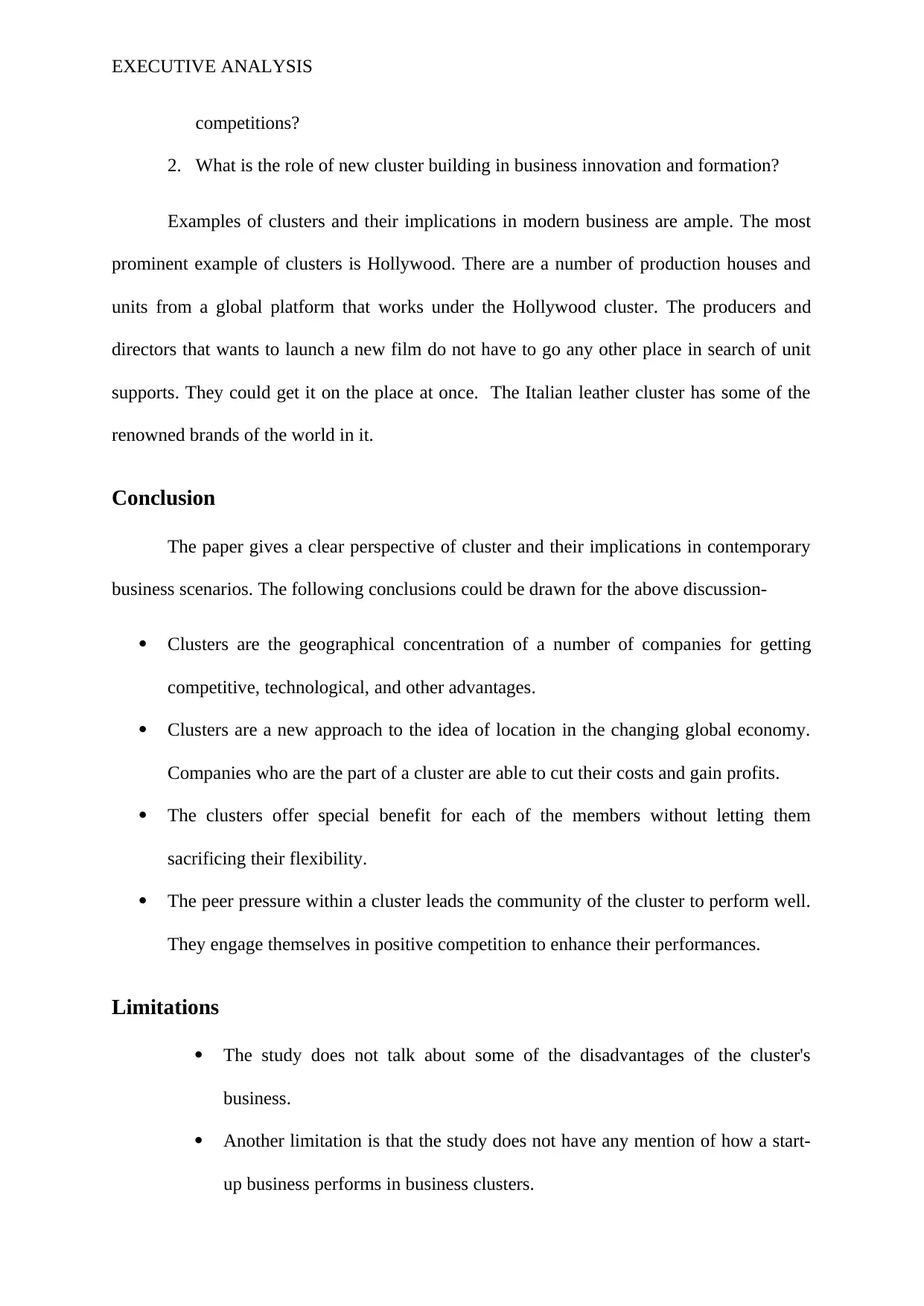
EXECUTIVE ANALYSIS
competitions?
2. What is the role of new cluster building in business innovation and formation?
Examples of clusters and their implications in modern business are ample. The most
prominent example of clusters is Hollywood. There are a number of production houses and
units from a global platform that works under the Hollywood cluster. The producers and
directors that wants to launch a new film do not have to go any other place in search of unit
supports. They could get it on the place at once. The Italian leather cluster has some of the
renowned brands of the world in it.
Conclusion
The paper gives a clear perspective of cluster and their implications in contemporary
business scenarios. The following conclusions could be drawn for the above discussion-
Clusters are the geographical concentration of a number of companies for getting
competitive, technological, and other advantages.
Clusters are a new approach to the idea of location in the changing global economy.
Companies who are the part of a cluster are able to cut their costs and gain profits.
The clusters offer special benefit for each of the members without letting them
sacrificing their flexibility.
The peer pressure within a cluster leads the community of the cluster to perform well.
They engage themselves in positive competition to enhance their performances.
Limitations
The study does not talk about some of the disadvantages of the cluster's
business.
Another limitation is that the study does not have any mention of how a start-
up business performs in business clusters.
competitions?
2. What is the role of new cluster building in business innovation and formation?
Examples of clusters and their implications in modern business are ample. The most
prominent example of clusters is Hollywood. There are a number of production houses and
units from a global platform that works under the Hollywood cluster. The producers and
directors that wants to launch a new film do not have to go any other place in search of unit
supports. They could get it on the place at once. The Italian leather cluster has some of the
renowned brands of the world in it.
Conclusion
The paper gives a clear perspective of cluster and their implications in contemporary
business scenarios. The following conclusions could be drawn for the above discussion-
Clusters are the geographical concentration of a number of companies for getting
competitive, technological, and other advantages.
Clusters are a new approach to the idea of location in the changing global economy.
Companies who are the part of a cluster are able to cut their costs and gain profits.
The clusters offer special benefit for each of the members without letting them
sacrificing their flexibility.
The peer pressure within a cluster leads the community of the cluster to perform well.
They engage themselves in positive competition to enhance their performances.
Limitations
The study does not talk about some of the disadvantages of the cluster's
business.
Another limitation is that the study does not have any mention of how a start-
up business performs in business clusters.
⊘ This is a preview!⊘
Do you want full access?
Subscribe today to unlock all pages.

Trusted by 1+ million students worldwide
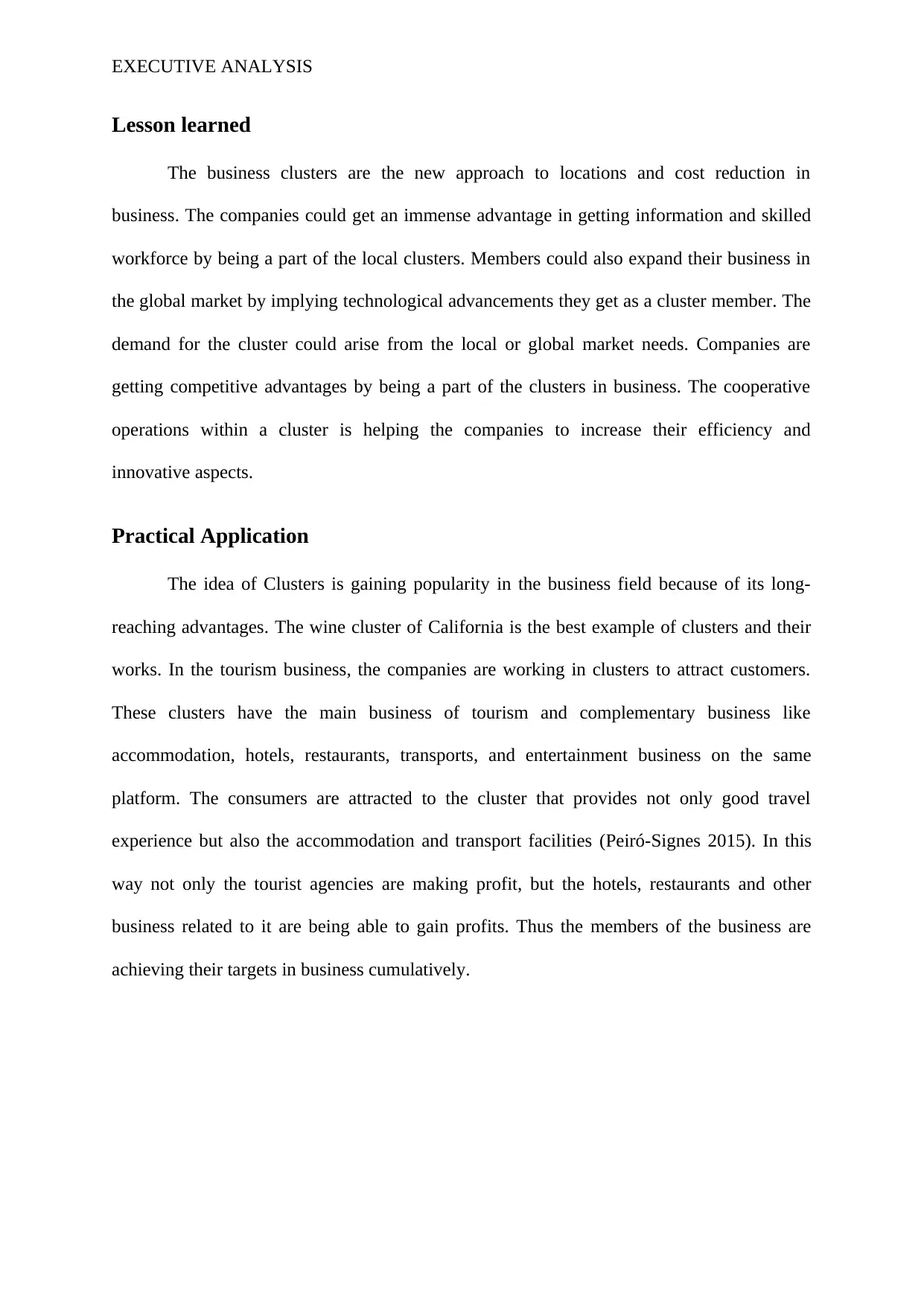
EXECUTIVE ANALYSIS
Lesson learned
The business clusters are the new approach to locations and cost reduction in
business. The companies could get an immense advantage in getting information and skilled
workforce by being a part of the local clusters. Members could also expand their business in
the global market by implying technological advancements they get as a cluster member. The
demand for the cluster could arise from the local or global market needs. Companies are
getting competitive advantages by being a part of the clusters in business. The cooperative
operations within a cluster is helping the companies to increase their efficiency and
innovative aspects.
Practical Application
The idea of Clusters is gaining popularity in the business field because of its long-
reaching advantages. The wine cluster of California is the best example of clusters and their
works. In the tourism business, the companies are working in clusters to attract customers.
These clusters have the main business of tourism and complementary business like
accommodation, hotels, restaurants, transports, and entertainment business on the same
platform. The consumers are attracted to the cluster that provides not only good travel
experience but also the accommodation and transport facilities (Peiró-Signes 2015). In this
way not only the tourist agencies are making profit, but the hotels, restaurants and other
business related to it are being able to gain profits. Thus the members of the business are
achieving their targets in business cumulatively.
Lesson learned
The business clusters are the new approach to locations and cost reduction in
business. The companies could get an immense advantage in getting information and skilled
workforce by being a part of the local clusters. Members could also expand their business in
the global market by implying technological advancements they get as a cluster member. The
demand for the cluster could arise from the local or global market needs. Companies are
getting competitive advantages by being a part of the clusters in business. The cooperative
operations within a cluster is helping the companies to increase their efficiency and
innovative aspects.
Practical Application
The idea of Clusters is gaining popularity in the business field because of its long-
reaching advantages. The wine cluster of California is the best example of clusters and their
works. In the tourism business, the companies are working in clusters to attract customers.
These clusters have the main business of tourism and complementary business like
accommodation, hotels, restaurants, transports, and entertainment business on the same
platform. The consumers are attracted to the cluster that provides not only good travel
experience but also the accommodation and transport facilities (Peiró-Signes 2015). In this
way not only the tourist agencies are making profit, but the hotels, restaurants and other
business related to it are being able to gain profits. Thus the members of the business are
achieving their targets in business cumulatively.
Paraphrase This Document
Need a fresh take? Get an instant paraphrase of this document with our AI Paraphraser
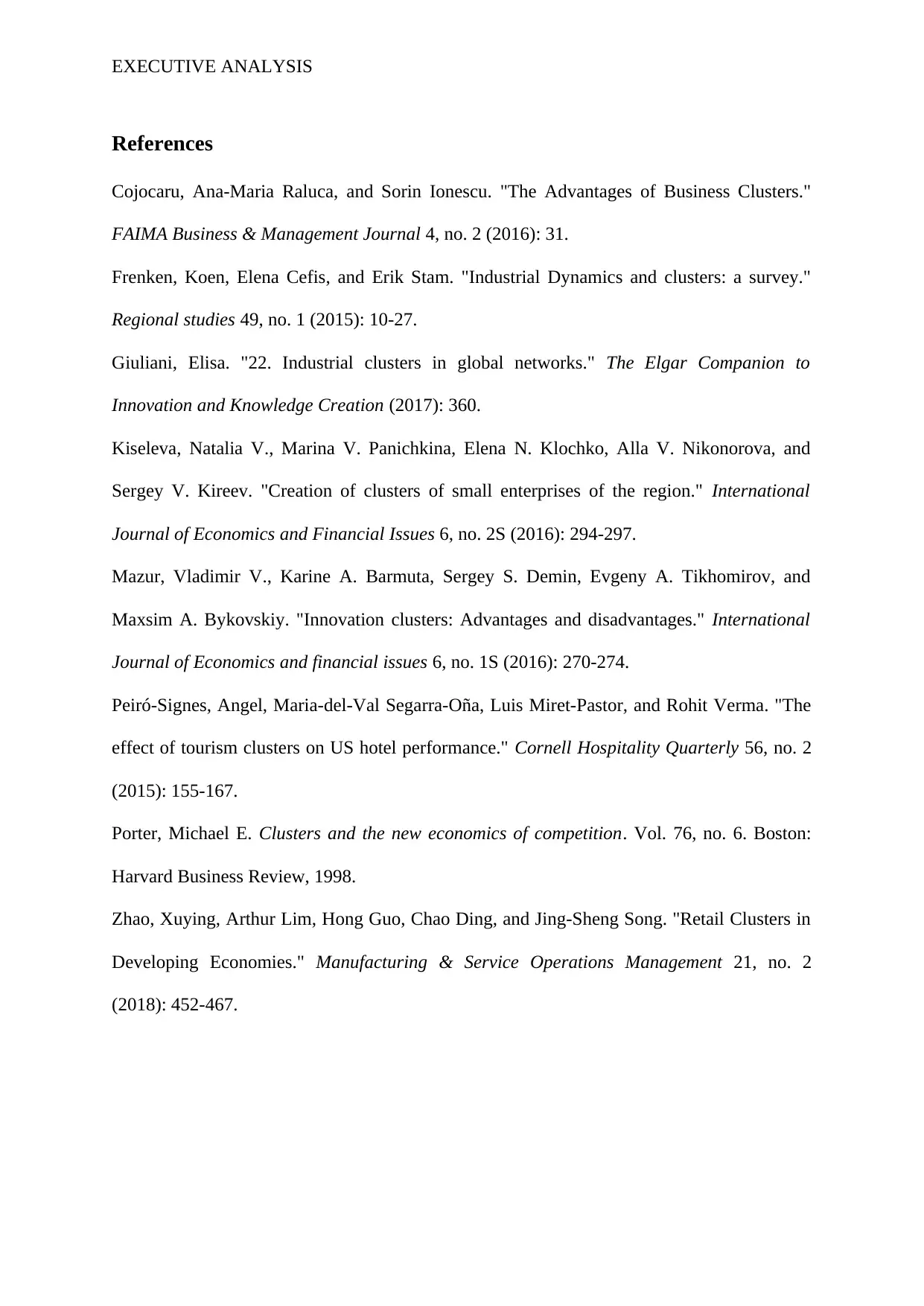
EXECUTIVE ANALYSIS
References
Cojocaru, Ana-Maria Raluca, and Sorin Ionescu. "The Advantages of Business Clusters."
FAIMA Business & Management Journal 4, no. 2 (2016): 31.
Frenken, Koen, Elena Cefis, and Erik Stam. "Industrial Dynamics and clusters: a survey."
Regional studies 49, no. 1 (2015): 10-27.
Giuliani, Elisa. "22. Industrial clusters in global networks." The Elgar Companion to
Innovation and Knowledge Creation (2017): 360.
Kiseleva, Natalia V., Marina V. Panichkina, Elena N. Klochko, Alla V. Nikonorova, and
Sergey V. Kireev. "Creation of clusters of small enterprises of the region." International
Journal of Economics and Financial Issues 6, no. 2S (2016): 294-297.
Mazur, Vladimir V., Karine A. Barmuta, Sergey S. Demin, Evgeny A. Tikhomirov, and
Maxsim A. Bykovskiy. "Innovation clusters: Advantages and disadvantages." International
Journal of Economics and financial issues 6, no. 1S (2016): 270-274.
Peiró-Signes, Angel, Maria-del-Val Segarra-Oña, Luis Miret-Pastor, and Rohit Verma. "The
effect of tourism clusters on US hotel performance." Cornell Hospitality Quarterly 56, no. 2
(2015): 155-167.
Porter, Michael E. Clusters and the new economics of competition. Vol. 76, no. 6. Boston:
Harvard Business Review, 1998.
Zhao, Xuying, Arthur Lim, Hong Guo, Chao Ding, and Jing-Sheng Song. "Retail Clusters in
Developing Economies." Manufacturing & Service Operations Management 21, no. 2
(2018): 452-467.
References
Cojocaru, Ana-Maria Raluca, and Sorin Ionescu. "The Advantages of Business Clusters."
FAIMA Business & Management Journal 4, no. 2 (2016): 31.
Frenken, Koen, Elena Cefis, and Erik Stam. "Industrial Dynamics and clusters: a survey."
Regional studies 49, no. 1 (2015): 10-27.
Giuliani, Elisa. "22. Industrial clusters in global networks." The Elgar Companion to
Innovation and Knowledge Creation (2017): 360.
Kiseleva, Natalia V., Marina V. Panichkina, Elena N. Klochko, Alla V. Nikonorova, and
Sergey V. Kireev. "Creation of clusters of small enterprises of the region." International
Journal of Economics and Financial Issues 6, no. 2S (2016): 294-297.
Mazur, Vladimir V., Karine A. Barmuta, Sergey S. Demin, Evgeny A. Tikhomirov, and
Maxsim A. Bykovskiy. "Innovation clusters: Advantages and disadvantages." International
Journal of Economics and financial issues 6, no. 1S (2016): 270-274.
Peiró-Signes, Angel, Maria-del-Val Segarra-Oña, Luis Miret-Pastor, and Rohit Verma. "The
effect of tourism clusters on US hotel performance." Cornell Hospitality Quarterly 56, no. 2
(2015): 155-167.
Porter, Michael E. Clusters and the new economics of competition. Vol. 76, no. 6. Boston:
Harvard Business Review, 1998.
Zhao, Xuying, Arthur Lim, Hong Guo, Chao Ding, and Jing-Sheng Song. "Retail Clusters in
Developing Economies." Manufacturing & Service Operations Management 21, no. 2
(2018): 452-467.
1 out of 8
Related Documents
Your All-in-One AI-Powered Toolkit for Academic Success.
+13062052269
info@desklib.com
Available 24*7 on WhatsApp / Email
![[object Object]](/_next/static/media/star-bottom.7253800d.svg)
Unlock your academic potential
Copyright © 2020–2025 A2Z Services. All Rights Reserved. Developed and managed by ZUCOL.




